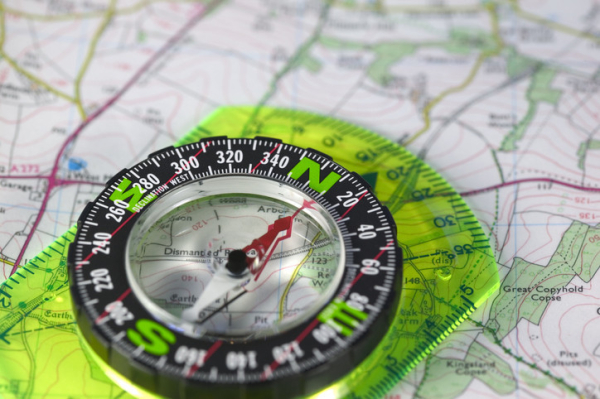
Picture this: you’re with friends in an unfamiliar forest using only a map and a compass to guide you to an upcoming checkpoint. There are no cell phones or GPS gadgets to help, just good old brainpower fueled by a sense of adventure as you wind through leafy trees and dappled sunlight.
This is not an excursion to a campsite or a treasure hunt. It’s a navigation sport called orienteering — a fun way to get outside, exercise, and maybe even help fight cognitive decline, according to a 2023 study.
What is orienteering?
Orienteering combines map and compass reading with exercise. Competitors (“orienteers”) race against a clock to reach checkpoints in outdoor settings that can range from city parks to remote areas with mountains, lakes, rivers, or snowy fields.
“You can go out in a group or on your own. You get a very detailed map and navigate your way to checkpoints that record your time electronically,” says Clinton Morse, national communications manager with Orienteering USA, the national governing body for the sport in the United States.
Because orienteers are racing the clock, they might run on trails, hike up hills, or scramble around boulders. That’s for foot-orienteering events. There are also orienteering events with courses geared for mountain biking, cross-country skiing, or canoeing.
How might orienteering affect thinking skills?
A small 2023 study published online in PLoS One found a potential link between orienteering and sharp thinking skills.
Researchers asked 158 healthy people, ages 18 to 87, about their health, activities, navigation abilities, and memory. About half of the participants had varying levels of orienteering experience. The other participants were physically active but weren’t orienteers.
Compared with study participants who didn’t engage in orienteering, those who were orienteers reported
- having better navigational processing skills (recognizing where objects were, and where participants were in relation to the objects)
- having better navigational memory skills (recalling routes and landmarks).
The study was observational — that is, not a true experiment — and thus didn’t prove that orienteering boosted people’s thinking skills. But the link might be plausible.
“Aerobic exercise releases chemicals in the brain that foster the growth of new brain cells. And when you use a map and connect it to landmarks, you stimulate growth between brain cells,” says Dr. Andrew Budson, lecturer in neurology at Harvard Medical School and chief of cognitive and behavioral neurology at VA Boston Healthcare System.
Where can you find orienteering opportunities?
There are about 70 orienteering clubs across the United States, and many more around the world (the sport is extremely popular in Europe). To find an orienteering event in your area, use the club finder tool offered by Orienteering USA.
How can you get started with orienteering?
People of all ages and athletic levels can take part, because orienteering courses vary from local parks to wilderness experiences. Costs are about $7 to $10 per person for local events, or $25 to $40 per person for national events, plus any travel and lodging expenses.
To make orienteering easy at first, Morse suggests going with a group and taking things slowly on a short novice course. “You don’t have to race,” he says. “Some people do this recreationally to enjoy the challenge of completing a course at their own pace.”
The trickiest part is learning to read the map. Morse’s advice:
- Turn the map as you change directions. Hold the map so that the direction you’re heading in is at the top of the page. For example, if the compass indicates that you’re heading south, turn the map upside down, so the south part is on top and easier to follow.
- Create a mental image of what the map is telling you. If there’s a fence along a field on the map, build a picture of it in your mind so you can recognize it when you see it, even if you haven’t been there before.
Tips for safe and enjoyable orienteering events:
- Dress appropriately. Wear comfortable clothes including long pants, good walking shoes, and a hat.
- Lather up. You’ll be outside for at least an hour, and you’ll need sunblock and possibly tick and bug spray depending on the terrain. Preventing tick bites that can lead to Lyme disease and other tick-borne illnesses is important in many locations.
- Bring some essentials. Pack water, a snack, sunblock, bug spray, and your phone. (Keep the phone turned off unless you need to call for help.)
- Use good judgment. Know that the shortest route on the map won’t always be the best, since it might take you up a hill or through thick vegetation. It might be better to go around those areas.
Once you learn the basics of orienteering, you can make it more physically challenging (and a better workout) by going faster and trying to beat your previous times, or by signing up for a more advanced course that’s longer and requires more exertion and speed.
And no matter which event you take part in, enjoy the adventure. “You’re not just following a path, you’re solving puzzles while being immersed in nature,” Morse says. “It’s a great way to experience the outdoors.”
About the Author

Heidi Godman, Executive Editor, Harvard Health Letter
Heidi Godman is the executive editor of the Harvard Health Letter. Before coming to the Health Letter, she was an award-winning television news anchor and medical reporter for 25 years. Heidi was named a journalism fellow … See Full Bio View all posts by Heidi Godman
About the Reviewer

Howard E. LeWine, MD, Chief Medical Editor, Harvard Health Publishing
Dr. Howard LeWine is a practicing internist at Brigham and Women’s Hospital in Boston, Chief Medical Editor at Harvard Health Publishing, and editor in chief of Harvard Men’s Health Watch. See Full Bio View all posts by Howard E. LeWine, MD
